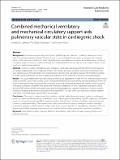Combined mechanical ventilatory and mechanical circulatory support aids pulmonary vascular state in cardiogenic shock
Author(s)
Lamberti, Kimberly K.; Edelman, Elazer R.; Keller, Steven P.
Download40635_2025_Article_811.pdf (1.056Mb)
Publisher with Creative Commons License
Publisher with Creative Commons License
Creative Commons Attribution
Terms of use
Metadata
Show full item recordAbstract
Background Percutaneous ventricular assist devices (pVADs) support patients in circulatory failure and increasingly concomitant respiratory failure. The presence of co-existent lung disease creates a management challenge due to cardiopulmonary interactions, especially when there is simultaneous mechanical ventilation and mechanical circulatory support. Enhanced understanding of the combined effects of these devices is necessary to better inform care for circulatory failure patients. Methods A porcine model of titratable acute cardiogenic shock was used to quantify the effect of pVAD support on cardiac loading states in five intubated animals with positive pressure ventilation and varied intrathoracic pressure. Cardiovascular hemodynamics were assessed across positive end-expiratory pressure (PEEP) ramps in animals in health, health with pVAD, and pVAD-supported cardiogenic shock induced via coronary microembolization. Results This study employed invasive physiological metrics and assessment of right and left ventricular press-volume loops to recreate classic Frank-Starling curves. Increased intrathoracic pressure altered transmural pressure in the ventricles and the pulmonary vasculature and resulted in decreased venous return and stroke volume while increasing end-diastolic pressure consistent with decreased ventricular compliance. In pVAD-supported cardiogenic shock, elevated PEEP enhanced left ventricular output and increased pulmonary vascular compliance in several animals, contrary to traditional decrements observed with elevated PEEP. The right ventricular functional response aligned with these varied responses in pulmonary vascular state. Conclusions These results demonstrate that combined used of cardiopulmonary support devices in cardiogenic shock can create variable responses compared to classic physiological understanding. In pVAD-supported cardiogenic shock, an increase in ventilatory PEEP increased unloading from the heart and improved right ventricular function, counter to traditional findings. This demonstrates that combined use of these technologies could be leveraged to optimize a patient’s volume status in complex shock and provides promise for management of patients with cardiopulmonary failure requiring simultaneous use of mechanical circulatory support and mechanical ventilation.
Date issued
2025-10-15Department
Institute for Medical Engineering and ScienceJournal
Intensive Care Medicine Experimental
Publisher
Springer International Publishing
Citation
Lamberti, K.K., Edelman, E.R. & Keller, S.P. Combined mechanical ventilatory and mechanical circulatory support aids pulmonary vascular state in cardiogenic shock. ICMx 13, 100 (2025).
Version: Final published version